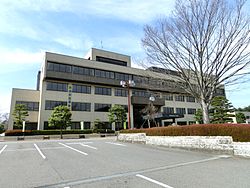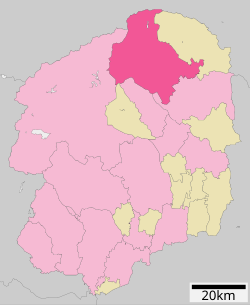|
Nasushiobara
 Nasushiobara (那須塩原市, Nasushiobara-shi) is a city located in Tochigi Prefecture, Japan. As of 1 August 2020[update], the city had an estimated population of 115,794 in 48,437 households,[1] and a population density of 67 persons per km². The total area of the city is 592.74 square kilometres (228.86 sq mi). GeographyNasushiobara is the northernmost city in the Kantō region of Japan, bordering Fukushima Prefecture to the north. It is located in the northern portion of Tochigi Prefecture, in the mountains. Surrounding municipalitiesClimateNasushiobara has a humid subtropical climate (Köppen Cfa) characterized by warm to hot summers and cool winters with heavy snowfall. The average annual temperature in Nasushiobara is 12.1 °C (53.8 °F). The average annual rainfall is 1,552.5 mm (61.12 in) with July as the wettest month. The temperatures are highest on average in August, at around 23.8 °C (74.8 °F), and lowest in January, at around 0.9 °C (33.6 °F).[2]
DemographicsPer Japanese census data,[4] the population of Nasushiobara has recently plateaued after a century of strong growth.
HistoryBefore the Meiji period, the area which is now Nasushiobara was mostly uninhabited wasteland, due to lack of suitable water for agriculture. Ōtawara Domain built a number of irrigation canals during the Edo Period, but the scale was small. However, in the Meiji period, the Nasu Canal and other agricultural development projects aimed at opening the region to farming led to rapid development, and many local place names still bear the names of various government officials of the Meiji period. With the establishment of the modern municipalities system on April 1, 1889, the villages of Karino, Takabayashi, Nabekake, Nishi-Nasuno, Higashi-Nasuno in Nasu District, and Shiobara in Shioya District were formed. A portion of Higashi-Nasuno became the town of Kuroiso in 1912. Shiobara became a town in 1919, and Nishi-Nasuno in 1932. In 1955, Kuroiso annexed Takabayashi, Nabekake and the remainder of Higashi-Nasuno, and Nishi-Nasuno annexed Kariya. Kuroiso became a city in 1970, and Shiobara was transferred to Nasu District in 1982. The modern city of Nasushiobara was established on January 1, 2005, from the merger of the former city of Kuroiso, and the towns of Nishinasuno and Shiobara (both previously constituent towns of Nasu District). GovernmentNasushiobara has a mayor-council form of government with a directly elected mayor and a unicameral city assembly of 26 members. Nasushiobara, together with the town of Nasu collectively contributes four members to the Tochigi Prefectural Assembly. In terms of national politics, the city is part of Tochigi 3rd district of the lower house of the Diet of Japan. EconomyNasushiobara relies heavily on seasonal tourism to its hot spring and ski resorts. Agriculture is centered on dairy production. The city mascot, Miruhi, was created to represent the city's dairy production. The city also has several industrial parks. Education
TransportationRailway
Highway
Local attractionsNasushiobara serves as a gateway for tourism in northern Tochigi.
Notable people
References
External links
|
||||||||||||||||||||||||||||||||||||||||||||||||||||||||||||||||||||||||||||||||||||||||||||||||||||||||||||||||||||||||||||||||||||||||||||||||||||||||||||||||||||||||||||||||||||||||||||||||||||||||||||||||||||||||||||||||||||||||||||||||||||||||||||||





